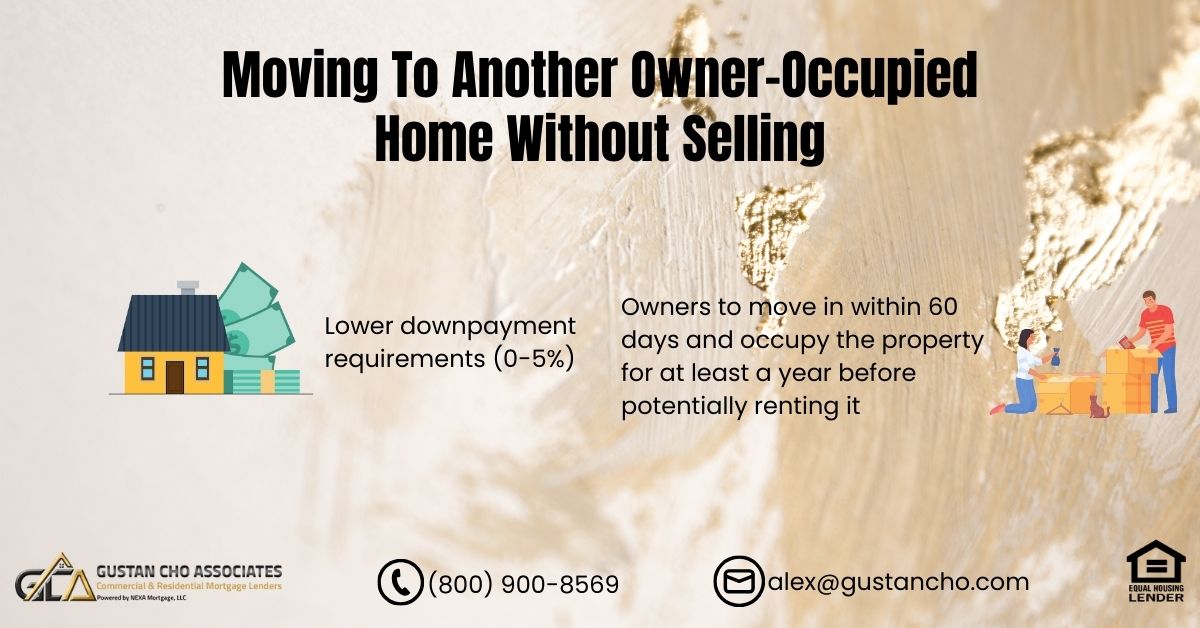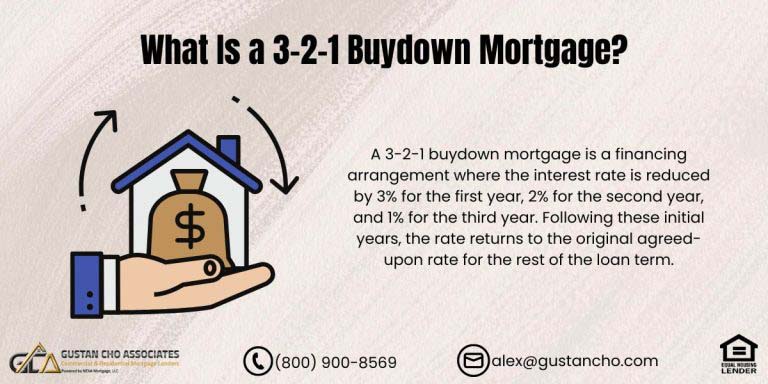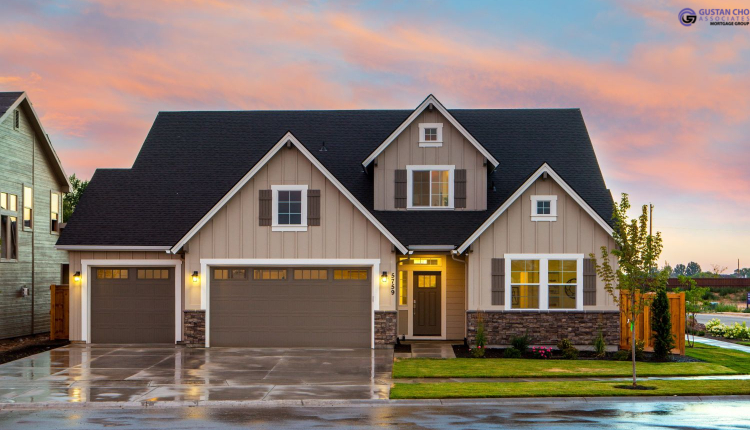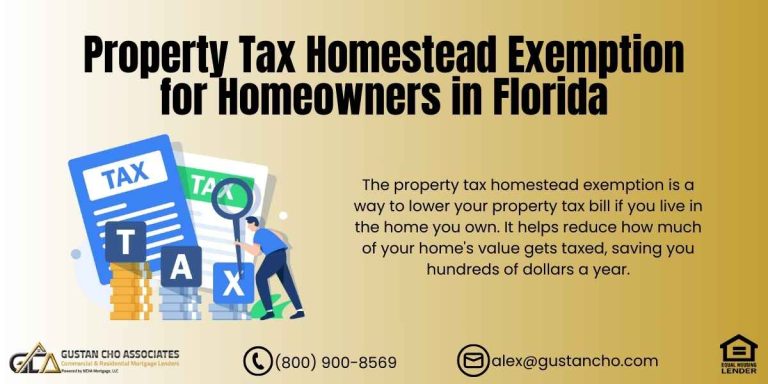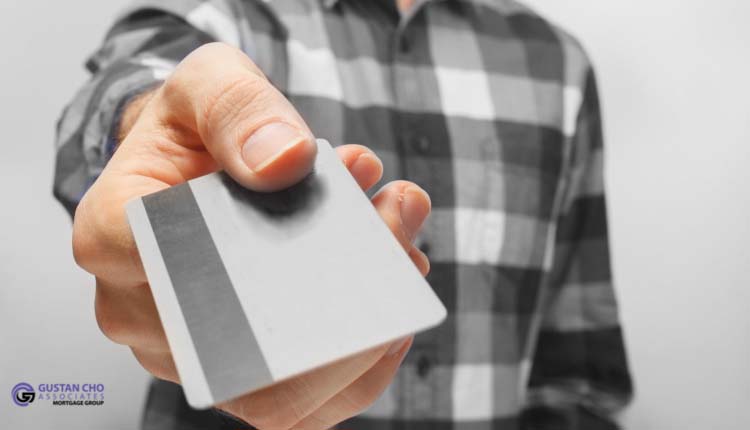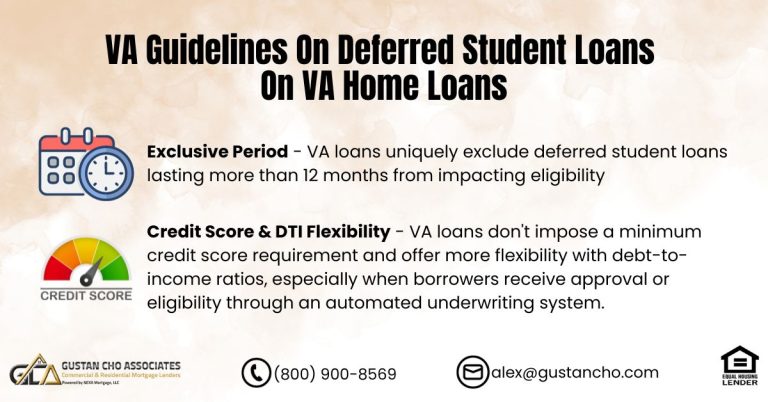In this blog, we will cover and discuss buying and moving to another owner-occupied home without selling their first home. There are strict rules and mortgage regulations with owner-occupant home financing. Gustan Cho Associates get countless calls from potential homebuyers about Moving To Another Owner-Occupied Home Without Selling their first home.
There are several variables we will cover in this blog on moving to another owner-occupied home with selling your first home.
Moving To Another Owner-Occupied Home Without Selling My First
If you’re considering purchasing a second owner-occupied home while keeping your first one, here’s what you need to know about lenders’ requirements. Yes, you can move to another owner-occupied property. However, lenders will examine specific factors to ensure your second home qualifies for financing.
How Far From First Home Moving To Another Owner-Occupied Home
Distance: Lenders often look at how far your new home is from your first one. If you’re buying a second home close by, you need to clearly justify why you’re making this move.
Reason for the Move: It’s important to articulate your reasons for relocating. Lenders want to understand your motivation for purchasing another primary residence instead of selling the first one.
Occupancy Proof: Finally, you’ll need to demonstrate that you own both properties. This may involve proving your residency status in both homes to satisfy lender requirements.
By breaking it down this way, you’ll have a clearer understanding of what lenders consider when you’re looking to buy a second owner-occupied home.
Benefits of Owner-Occupied Financing
Financing for owner-occupied properties offers significant advantages compared to financing for investment homes. In addition to the down payment requirements that can range from zero to 5 percent, the overall terms of owner-occupied financing surpass those of mortgages for investment properties.
Why Are You Moving To Another Owner-Occupied Home?
If your current residence is adjacent or within a short driving distance, what rationale exists for the lender to doubt that it won’t be considered an investment property?
The transaction must be logically sound. Are you downsizing because your children have grown and moved out? Are you relocating to another owner-occupied property to enhance your living situation due to a growing family? Have you experienced a marriage or divorce, necessitating an upgrade to a larger home or a downsizing to a smaller one?
Beyond the reasons for upsizing or downsizing, other circumstances are reasonable for the lender and underwriters. If you’re transitioning to another owner-occupied property, mortgage underwriters will require a letter of explanation detailing the reasons for the move and clarifying the occupancy.
Ready to Move to a New Home Without Selling Your Current One?
Contact us today to explore financing options that allow you to keep your current home while purchasing another one.
What Are Some Reasons Mortgage Underwriters Find Owner-Occupancy Acceptable
You are required to compose a letter clarifying the transition to another owner-occupied residence without selling the initial one for the mortgage underwriter. When drafting a letter of explanation for the mortgage underwriter, consider the following key points.
The objective is to elucidate your move to another owner-occupied residence, emphasizing that you will genuinely reside there.
Can I Get Approved For Another Owner-Occupant Home Due To New Job?
Are you relocating to a different owner-occupied residence to reduce commuting distance to work? Are you transitioning to another owner-occupied dwelling to fulfill the responsibilities of caring for elderly parents? Is the move to another owner-occupied home driven by proximity to medical facilities due to long-term health issues?
It is crucial for the relocation to another owner-occupied residence to align with the criteria set by the new lender, and borrowers must adhere to the rules associated with owner-occupancy.
How Do I Write a Letter of Explanation For Occupancy?
If you plan to relocate to another owner-occupied residence without selling your initial home or intend to retain the property as an investment rental, the lender will request you to provide a letter of explanation regarding occupancy. Margarett Jurilla, the Regional Branch Operations Director at Gustan Cho Associates, shared the following insights on this matter:
The letter of explanation (LOX) should be simple and concise, as mortgage underwriters tend to favor brief letters that are only a few sentences long rather than lengthy multi-page narratives. To enhance clarity, bullet points within the letter are recommended. Additionally, the LOX must be legible and easy to follow and include dates for each chain of events.
Accompanying the letter with factual information and supporting documents can further strengthen your explanation and add credibility to your claims.
When writing a letter of explanation, consider the following points:
- Keep your narrative focused on the key subject matter.
- Avoid lengthy descriptions; present a factual chain of events with proper dates.
- Underwriters are primarily interested in facts, not stories.
- Supporting documents will strengthen your case. If you want the underwriter to believe you are moving to a new home while keeping your existing home as a rental, include relevant documents and reasons.
Example Letter of Explanation (LOX):
[Your Name]
[Your Address]
[City, State, Zip Code]
[Email Address]
[Phone Number]
[Date]
[Underwriter’s Name]
[Mortgage Company Name]
[Company Address]
[City, State, Zip Code]
Subject: Letter of Explanation for Property Occupancy
Dear [Underwriter’s Name],
I am writing to explain my current housing situation:
– **Current Property:** [Address of the current home]
– Occupied since: [Date]
– **New Property:** [Address of the new home]
– Purchase agreement date: [Date]
– Planned move-in date: [Date]
– I intend to retain my current home as a rental property once I move into my new residence.
– Attached is the purchase agreement for the new property and the lease agreement for the current property as supporting documentation.
Thank you for your consideration.
Sincerely,
[Your Name]
—
This simplified format clearly explains your situation without overwhelming details, making it easier for the underwriter to grasp the necessary facts quickly.
What Are The Owner-Occupant Financing Mortgage Rules?
Whether you’re transitioning to a new owner-occupied residence and selling your initial home or retaining it as an investment property, it is essential to adhere to and comply with the regulations governing owner-occupied housing. According to Michael Gracz, a loan officer assistant at Gustan Cho Associates, here’s what you need to know:
Primary owner-occupant homes are considered the safest investment for lenders. In the lending world, the safer the investment, the lower the risk, therefore the lower the rate. The riskier the borrower and property, the higher the rewards which means the higher the rate.
Owner occupant homebuyers need to move in the property within 60 days of the closing date and occupy the property for at least a year. After one year, they can rent the property and purchase a different owner-occupant home.
The fundamental point is that homes occupied by their owners typically come with reduced down payment prerequisites and more favorable mortgage rates. In contrast, properties intended for investment necessitate a 20% down payment and come with significantly elevated mortgage rates.
Thinking of Moving but Don’t Want to Sell Your Current Home?
Contact us today to find out how we can help you with the financing options that make it possible.
Owner-Occupant Versus Investment Home Financing Guidelines
You need to make sure that your reason for moving to a different owner-occupied home matches what the lender and mortgage underwriter expect. The mortgage underwriter must be convinced you are moving to establish a new primary residence, not purchasing an investment property.
How Can I Come Up With The Down Payment For Moving To Another Owner-Occupied Home
After establishing a valid rationale and confirming that transitioning to a new owner-occupied residence is the primary objective, and you intend to sell your initial home, another viable option for generating funds for the down payment and closing costs when moving to another owner-occupied property without selling your first home is to liquidate valuable assets.
This may include items such as a secondary vehicle, jewelry, collectibles, or memorabilia.
Selling Your First Home After Moving To Another Owner-Occupied Home?
Are you planning on selling your first home after moving to another owner-occupied home? Or are you planning to turn your first home into a rental after moving to another owner-occupied home. In the following paragraphs, we will discuss moving to another owner-occupied home without selling your first.
We will go over how to obtain a second mortgage on a new owner-occupant home. We will cover what happens with the mortgage of your first home when you are planning to move to another owner-occupied home.
Moving To Another Owner-Occupied Home Without Selling My First
Many individuals are inquiring whether they can meet the eligibility criteria for a second primary owner-occupied home without having to sell their first home.
A majority of homebuyers aspire to acquire their residences as owner-occupied homes due to the advantageous mortgage rates associated with such financing. Owner-occupied homes also entail the minimum down payment for a home purchase.
It’s important to note that all government loans are exclusively designated for owner-occupied homes. Prospective buyers interested in second homes or investment properties are ineligible for FHA, VA, or USDA loans. Only conventional loans facilitate financing for second homes and investment properties.
Lenders perceive owner-occupied homes as posing the least risk since homeowners are less likely to abandon their primary residences during financial difficulties compared to second homes or investment properties.
Consideration When Buying and Moving To Another Owner-Occupied Home
Prospective homebuyers who presently possess a primary residence and are contemplating a move to another primary residence, with the option of either selling the current property post-relocation or retaining it as a rental, should carefully weigh various factors.
Foremost among these considerations is ensuring that the acquisition of the new primary residence aligns with practical and logical considerations.
Moving To Another Owner-Occupied Home Due To Job Transfer
For individuals looking to buy a new home after receiving a job transfer located 60 miles or more from their current residence, the arrangement becomes viable.
Opting for the owner-occupied route would likely make them eligible for the new home purchase. It’s possible to qualify for Two FHA Loans Simultaneously if the new home is at least 100 miles away, and the move is necessitated by a job transfer.
On the contrary, if home buyers are acquiring a property near their current owner-occupied home, with the new one being of similar value and size, the proposition becomes impractical.
Consideration When Qualifying For A Second Owner-Occupant Home Mortgage
Alternatively, if the new home being bought is close to the current owner-occupied residence, yet significantly larger, and the motivation for relocating is the family outgrowing the current owner-occupied home, then the purchase of the new home will be considered as an owner-occupied property.
Upsizing or Downsizing Home Due To Change In Size of Household
When we say “substantially larger,” we mean a square footage increase of at least 30% or more. Other factors may also come into play, like downsizing to a townhome, condominium, or a smaller home because the borrower’s children no longer reside with them.
Before deciding to buy another home as an owner-occupied residence, it’s advisable to consult with a mortgage lender to determine if the deal can be structured as an owner-occupied property. There are additional considerations that should be taken into account.
Looking to Buy a New Home and Keep Your Current One?
Get in touch today to learn how you can make this move with the right financing solutions.
Purchasing and Moving To Another Owner-Occupied Home
If you intend on keeping your current owner-occupied home and buying another owner-occupied home, you need to qualify for both mortgage loans. There are instances where having two mortgage payments can disqualify you due to going over the required debt-to-income ratio requirements.
One way to solve this problem will be to state that the first owner-occupied home will be a rental and that the home buyers will be renting an existing home after they move to a new owner-occupied home.
Can I Use Rental Income From The Vacating Primary Residence?
Many people at Gustan Cho Associates ask if they can use rental income from their old primary residence.
Mortgage lenders usually want homeowners to have at least 25% equity in their property when moving. If that equity isn’t there, homeowners can skip refinancing.
However, they still need to appraise the original property and make mortgage payments until their loan-to-value ratio reaches 75%, giving them that 25% equity. During the appraisal, the appraiser will find out the market rental rate for the property. The mortgage lender will then consider 75% of that rate as rental income.
How Do You Use Rental Income As Income When Qualifying For New Mortgage?
A common question at Gustan Cho Associates is how to use rental income when applying for a loan. Sometimes, homeowners move in with a spouse and rent out their current home.
If the homeowner plans to rent their house and needs extra income to qualify for a loan, they can use up to 75% of the expected rental income. To do this, the borrower should provide a signed lease and a copy of the canceled security deposit check.
The lender will request the appraiser for the average market rent for a comparable property.
Rental Income Can Be Verified With Rent Lease
If the homeowner possesses a rental lease and has consistently reported the rental income from their owner-occupied residence on their tax returns for a minimum of two years, then the entirety of the rental income declared on their tax returns is eligible for consideration.
In this specific scenario, 100% of the rental income can be utilized, as opposed to 75% of the market rent, given that it has been documented in their tax filings.
Qualifying For Mortgage With Mortgage Lender With No Overlays
Home Buyers who need to qualify for government and/or conventional loans with a national mortgage company licensed in multiple states with no overlays on government and conventional loans, please contact us at Gustan Cho Associates at 800-900-8569 or text us for a faster response. Or email us at gcho@gustancho.com.
The team at Gustan Cho Associates is available 7 days a week, evenings, weekends, and holidays. Gustan Cho Associates has a national reputation for not having any lender overlays on government and conventional loans.
Gustan Cho Associates are also experts on non-QM loans and other alternative financing loan programs for owner-occupants, second homes, and investment properties. We are proud to have a reputation of being a one-stop lending shop.
FAQ: Moving To Another Owner-Occupied Home Without Selling
Q: What are the key considerations when moving to another owner-occupied home?
A: Several factors are important, including the distance between your current and new owner-occupied homes, the reasons for the move, and the rules associated with owner-occupancy financing.
Q: What are the Benefits of Owner-Occupied Financing?
A: Owner-occupied financing typically offers lower down payment requirements (0-5%), more favorable mortgage terms, and lower interest rates compared to investment property financing.
Q: Why is it Crucial to Explain the Reasons for the Move to Mortgage Underwriters?
A: Mortgage underwriters need a clear explanation for your move to another owner-occupied property to ensure it aligns with the lender’s criteria and is not considered an investment property.
Q: Can I Get Approved for Another Owner-Occupied Home Due to a New Job?
A: If you’re moving to reduce commuting distance for work or other valid reasons, you may be eligible for a new owner-occupied home. However, you must adhere to lender and underwriting rules.
Q: How do I Write a Letter of Explanation for Occupancy?
A: When writing a letter of explanation, keep it concise, factual, and supported by documentation. Focus on the subject matter and make it clear and convincing, as if presenting a case in court.
Q: What are the Mortgage Rules for Owner-Occupied Financing?
A: Owner-occupied properties generally require moving in within 60 days of closing and residing there for at least a year. The primary residence is considered a safer investment for lenders, resulting in lower rates.
Q: How Can I Come Up with the Down Payment for the New Owner-Occupied Home?
A: Liquidating valuable assets such as secondary vehicles, jewelry, collectibles, or memorabilia can help generate funds for the down payment and closing costs when moving to another owner-occupied property.
Q: What Happens to My First Home’s Mortgage When Moving to Another Owner-Occupied Home?
A: If you plan to retain your first home as a rental, you may use rental income to support your mortgage application, subject to certain equity and documentation requirements.
Q: Can I Use Rental Income from My Former Primary Residence to Qualify for a New Mortgage?
A: You may use up to 75% of the potential rental income if your former primary residence will be used as a rental property and additional income is needed to meet debt-to-income ratio requirements. Documentation and a lease agreement are necessary.
This article on moving to another owner-occupied home without selling the first home was updated on April 25th, 2025.
Want to Move to a New Home and Keep Your Existing Property?
Reach out now to find out how we can help you secure financing for both properties.


